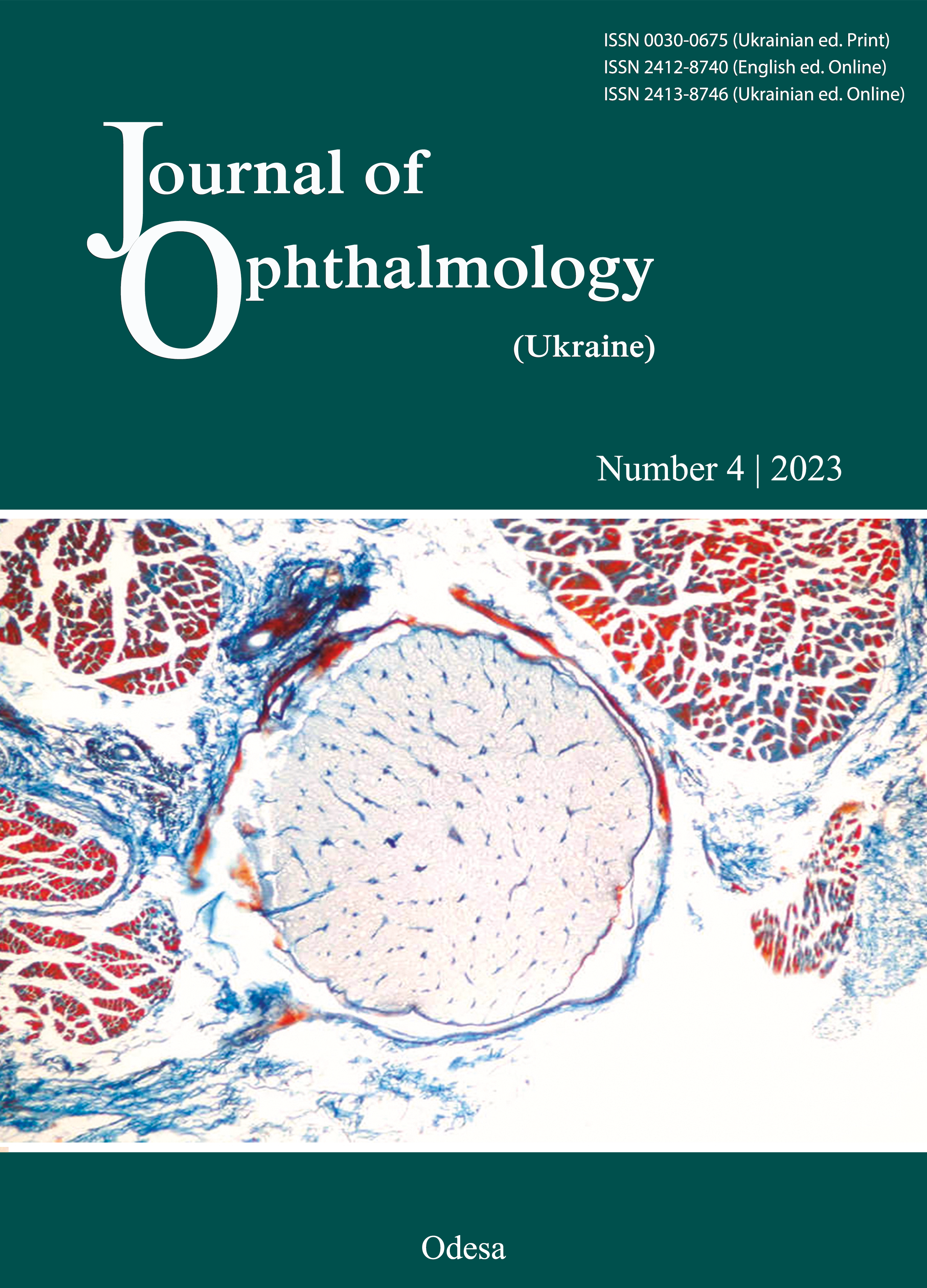Combined effect of carrying both CFH (rs1061170) and TGFβ1 (rs1800469) gene variants on the risks of various forms of age-related macular degeneration
DOI:
https://doi.org/10.31288/oftalmolzh202342633Keywords:
age-related macular degeneration, geographic atrophy, TGFΒ1 rs1800469 variant, CFH rs1061170 variantAbstract
Background: Age-related macular degeneration (AMD) is one of the most common disorders that can lead to total central vision loss after choroidal neovascularization or geographic atrophy (GA). Because the genetic component of the disease plays an important role in the pathogenesis, has an impact on the clinical presentation, and determines the response to treatment, studies on the genetic component of AMD are relevant for better understanding the molecular mechanisms underlying the pathogenesis.
Purpose: To investigate associations among TGFβ1 C509T (rs1800469) and CFH T1277С (rs1061170) polymorphisms, their gene-to-gene interactions and the risks of various forms of AMD.
Material and Methods: This was a case-control study. The case group included 61 patients with AMD. Of these, 31 were diagnosed with late dry AMD (GA), and 30, with wet AMD (neovascular AMD or nAMD). Patients with nAMD were divided into two subgroups of 14 patients with type 1 or occult subretinal neovascular membrane (SNM), the SNM1 subgroup and 16 patients with type 2 or classical SNM, the SNM2 subgroup. The control group was composed of 50 individuals with no eye disease and of an age distribution similar to that of the case group. Polymerase chain reaction (PCR) and restriction analysis of gene amplification products were performed to determine TGFβ1 rs1800469 and CFH rs1061170.
Results: We found a significant effect of TGFβ1 C509T (rs1800469) and CFH T1277C (rs1061170) gene variants on the risks of various forms of AMD. CFH 1277TT genotype was associated with decreased AMD risk, whereas 1277CC genotype, with increased AMD risk (first and foremost, increased GA risk) (р < 0.05). TGFβ1 509CC genotype was associated with increased risk, whereas TGFβ1 509TT genotype, with decreased risk of both GA and SNM2.
Conclusion: For the first time, a combined effect of gene variants of interest on the susceptibility to the development of AMD has been investigated, and synergism between these variants in increasing the risk of certain forms of the disease (e.g., GA) established. The results obtained create prerequisites for developing individualized prediction of risk and novel treatment strategies for the disease.
References
Brandl C, Breinlich V, Stark KJ, et al. Features of Age-Related Macular Degeneration in the General Adults and Their Dependency on Age, Sex, and Smoking: Results from the German KORA Study. PLoS One. 2016;11(11):e0167181. https://doi.org/10.1371/journal.pone.0167181
Li JQ, Welchowski T, Schmid M, et al. Prevalence and incidence of age-related macular degeneration in Europe: a systematic review and meta-analysis. Br J Ophthalmol. 2020;104(8):1077-84. https://doi.org/10.1136/bjophthalmol-2019-314422
Zhou M, Duan PC, Liang JH, et al. Geographic distributions of age-related macular degeneration incidence: a systematic review and meta-analysis. Br J Ophthalmol. 2021;105(10):1427-34. https://doi.org/10.1136/bjophthalmol-2020-316820
Shin HT, Yoon BW, Seo JH. Comparison of risk allele frequencies of single nucleotide polymorphisms associated with age-related macular degeneration in different ethnic groups. BMC Ophthalmol. 2021;21: 97. https://doi.org/10.1186/s12886-021-01830-9
Shughoury A, Sevgi DD, Ciulla TA. Molecular Genetic Mechanisms in Age-Related Macular Degeneration. Genes (Basel). 2022;13(7):1233. https://doi.org/10.3390/genes13071233
Malachkova NV, Yatsenko DA, Ljudkevich GP, et al. Polymorphism of TGF-β1 (rs1800469) in children with different degrees of myopia. Oftalmol Zh. 2018;5(484):45-8. https://doi.org/10.31288/oftalmolzh201854548
Klein RJ, Zeiss C, Chew EY, et al. Complement factor H polymorphism in age-related macular degeneration. Science. 2005;308(5720):385-9. https://doi.org/10.1126/science.1109557
Supanji S, Romdhoniyyah DF, Sasongko MB, et al. Associations of ARMS2 and CFH Gene Polymorphisms with Neovascular Age-Related Macular Degeneration. Clin Ophthalmol. 2021;15:1101-1108. https://doi.org/10.2147/OPTH.S298310
Kato Y, Oguchi Y, Omori T, et al. Age-Related Maculopathy Susceptibility 2 and Complement Factor H Polymorphism and Intraocular Complement Activation in Neovascular Age-Related Macular Degeneration. Ophthalmol Sci. 2022;2(2):100167. https://doi.org/10.1016/j.xops.2022.100167
Derakhshan A, Tavakkol-Afshari J, Sadeghi AAJ, et al. The Association Between the Transforming Growth Factor Beta-1 -509C>T Gene Polymorphism and Primary Open Angle Glaucoma in North Eastern Iran. Rep Biochem Mol Biol. 2019 Jan;7(2):167-173.
Meng B, Li SM, Yang Y, et al. The association of TGFB1 genetic polymorphisms with high myopia: a systematic review and meta-analysis. Int J Clin Exp Med. 2015;8(11):20355-67.
Ezzeldin N, El-Lebedy D, Darwish A, et al. Complement factor H polymorphism rs1061170 and the effect of cigarette smoking on the risk of lung cancer. Contemp Oncol (Pozn). 2015;19(6):441-5. https://doi.org/10.5114/wo.2015.56202
Peretiahina D, Shakun K, Ulianov V, Ulianova N. The Role of Retinal Plasticity in the Formation of Irreversible Retinal Deformations in Age-Related Macular Degeneration. Curr Eye Res. 2022;47(7):1043-1049. https://doi.org/10.1080/02713683.2022.2059810
Ulianova NA, Peretiahina DO. SS-OCT-derived morphometric changes in the choroid in patients with age-related macular degeneration. J Ophthalmol (Ukraine). 2019;6:63-9. https://doi.org/10.31288/oftalmolzh201966369
Korol A, Bezkorovayna I, Karliychuk M, Lutsenko N, Sergienko A, Ulyanova N, et al. Treatment approaches to patients with neovascular age-related macular degeneration who need frequent intravitreal injections of aflibercept. J Ophthalmol (Ukraine). 2022;96(1):80-83. https://doi.org/10.31288/oftalmolzh202218083
Korol A, Kustryn T, Zadorozhnyy O, Pasyechnikova N, Kozak I. Comparison of efficacy of intravitreal ranibizumab and aflibercept in eyes with myopic choroidal neovascularization: 24-month follow-up. J Ocul Pharmacol Ther. 2020;36(2):122-125. https://doi.org/10.1089/jop.2019.0080
Umanets N, Korol A, Vit V, Zavodnaya V, Pasyechnikova N. Peculiarities of vitrectomy and morphologic changes in thee piretinal membrane after intravitreal aflibercept in patients with severe proliferative diabetic retinopathy. Retinal Cases Brief Rep. 2017;11(2):114-118. https://doi.org/10.1097/ICB.0000000000000306
Colijn JM, Meester-Smoor M, Verzijden T, et al. Lifestyle, and Age-Related Macular Degeneration in Europe: The EYE-RISK Consortium. Ophthalmology. 2021;128(7):1039-1049. https://doi.org/10.1016/j.ophtha.2020.11.024
Chakravarthy U, McKay GJ, de Jong PT, et al. ARMS2 increases the risk of early and late age-related macular degeneration in the European Eye Study. Ophthalmology. 2013;120(2):342-8. https://doi.org/10.1016/j.ophtha.2012.08.004
Tzoumas N, Hallam D, Harris CL, et al. Revisiting the role of factor H in age-related macular degeneration: Insights from complement-mediated renal disease and rare genetic variants. Surv Ophthalmol. 2021;66(2):378-401. https://doi.org/10.1016/j.survophthal.2020.10.008
Molins B, Fuentes-Prior P, Adán A, et al. Complement factor H binding of monomeric C-reactive protein downregulates proinflammatory activity and is impaired with at risk polymorphic CFH variants. Sci Rep. 2016;6:22889. https://doi.org/10.1038/srep22889
Kubicka-Trząska A, Żuber-Łaskawiec K, Dziedzina S, et al. Genetic Variants of Complement Factor H Y402H (rs1061170), C2 R102G (rs2230199), and C3 E318D (rs9332739) and Response to Intravitreal Anti-VEGF Treatment in Patients with Exudative Age-Related Macular Degeneration. Medicina (Kaunas). 2022;58(5):658. https://doi.org/10.3390/medicina58050658
Alic L, Papac-Milicevic N, Czamara D, et al. A genome-wide association study identifies key modulators of complement factor H binding to malondialdehyde-epitopes. Proc Natl Acad Sci USA. 2020;117(18):9942-9951. https://doi.org/10.1073/pnas.1913970117
Laine M, Jarva H, Seitsonen S, et al. Y402H polymorphism of complement factor H affects binding affinity to C-reactive protein. J Immunol. 2007;178(6):3831-6. https://doi.org/10.4049/jimmunol.178.6.3831
Cao S, Wang JC, Gao J, et al. CFH Y402H polymorphism and the complement activation product C5a: effects on NF-κB activation and inflammasome gene regulation. Br J Ophthalmol. 2016;100(5):713-8. https://doi.org/10.1136/bjophthalmol-2015-307213
Maugeri A, Barchitta M, Agodi A. The association between complement factor H rs1061170 polymorphism and age-related macular degeneration: a comprehensive meta-analysis stratified by stage of disease and ethnicity. Acta Ophthalmol. 2019;97(1):e8-e21. https://doi.org/10.1111/aos.13849
Menghini M, Kloeckener-Gruissem B, Fleischhauer J, et al. Impact of loading phase, initial response and CFH genotype on the long-term outcome of treatment for neovascular age-related macular degeneration. PLoS One. 2012;7(7):e42014. https://doi.org/10.1371/journal.pone.0042014
Peng XQ, Cheng F, Zhou L. Association Between Transforming Growth Factor-β1 Polymorphisms and Ischemic Stroke Susceptibility: A Meta-Analysis. Clin Appl Thromb Hemost. 2023;29:10760296231166666. https://doi.org/10.1177/10760296231166666
Shah R, Hurley CK, Posch PE. A molecular mechanism for the differential regulation of TGF-beta1 expression due to the common SNP -509C-T (c. -1347C > T). Hum Genet. 2006;120(4):461-9. https://doi.org/10.1007/s00439-006-0194-1
Rudnicka AR, Jarrar Z, Wormald R, et al. Age and gender variations in age-related macular degeneration prevalence in populations of European ancestry: a meta-analysis. Ophthalmology. 2012;119(3):571-80. https://doi.org/10.1016/j.ophtha.2011.09.027
Downloads
Published
How to Cite
Issue
Section
License
Copyright (c) 2023 Дар'я Перетягіна, Надія Ульянова , Л.Є. Фіщук, З.І. Россоха

This work is licensed under a Creative Commons Attribution 4.0 International License.
This work is licensed under a Creative Commons Attribution 4.0 International (CC BY 4.0) that allows users to read, download, copy, distribute, print, search, or link to the full texts of the articles, or use them for any other lawful purpose, without asking prior permission from the publisher or the author as long as they cite the source.
COPYRIGHT NOTICE
Authors who publish in this journal agree to the following terms:
- Authors hold copyright immediately after publication of their works and retain publishing rights without any restrictions.
- The copyright commencement date complies the publication date of the issue, where the article is included in.
DEPOSIT POLICY
- Authors are permitted and encouraged to post their work online (e.g., in institutional repositories or on their website) during the editorial process, as it can lead to productive exchanges, as well as earlier and greater citation of published work.
- Authors are able to enter into separate, additional contractual arrangements for the non-exclusive distribution of the journal's published version of the work with an acknowledgement of its initial publication in this journal.
- Post-print (post-refereeing manuscript version) and publisher's PDF-version self-archiving is allowed.
- Archiving the pre-print (pre-refereeing manuscript version) not allowed.












